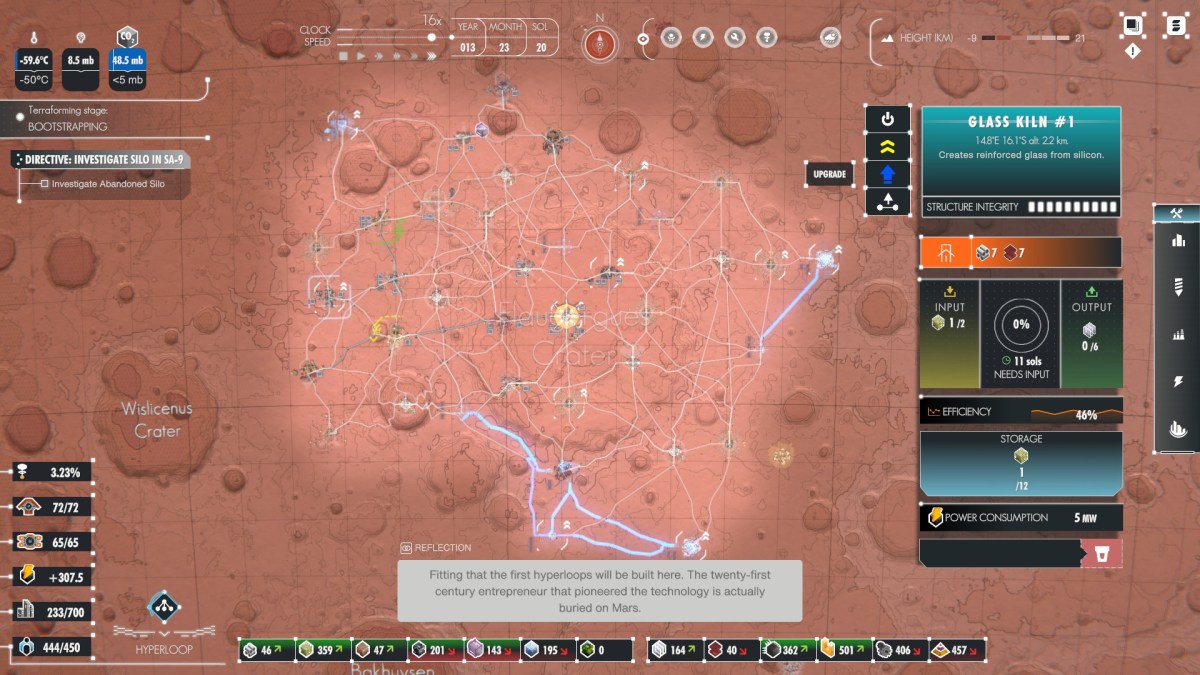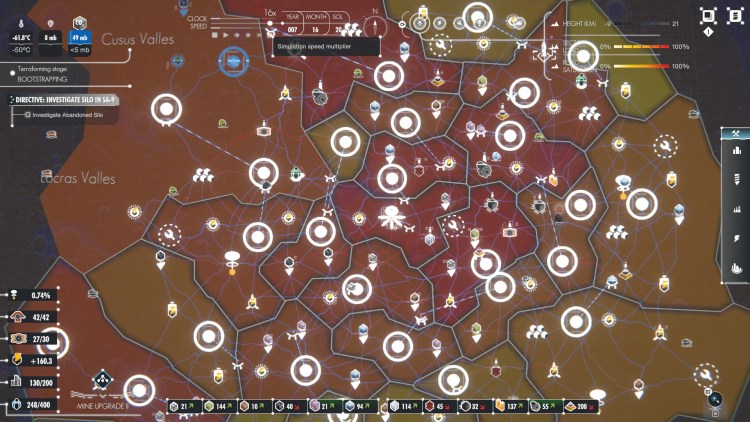Mars is just a boring dead ball of rust-colored dust. That just will not do. We have to turn it into something useful, something humans could live on. That’s precisely what you do in Per Aspera.
In Per Aspera, Mars is already littered with detritus of past human attempts to take a foothold on the planet. But now, it’s time to bring out the big guns: AMI. She’s an artificial intelligence, modeled on the human brain, and assigned to make Mars livable. That’s you. You play as AMI and guiding her hand in turning the Red Planet green.
Per Aspera is but the latest game to ride the zeitgeist of Mars colonization projects. Maybe everyone just liked a movie about Matt Damon growing potatoes in space. Maybe it’s a reaction to our world continuing to address climate crisis in wildly inadequate ways. Who knows why we’re doing what we’re doing — this game is aiming ambitiously high.
You see this planet? It’s ours now!
In Per Aspera, your map is the entire planet, and your eventual goal is to make it sustain human life. While you still build bases and extracting materials, the scope of your activities is much bigger than in similar games. Yet your base starts ever so humbly, with a hub that acts as both resource storage and power generator and a single worker. The worker is a wheeled drone, able of ferrying resources and constructing (or tearing down) structures, and you won’t control them directly. You plop down buildings — the first one invariably being an aluminum mine — and hope your workers get to it in due time.

A bigger nerd than I could probably find out how big these structures are by comparing their dimensions to the Olympus Mons in game. I’m just guessing that they’re huge.
You can coax them to prioritize by setting buildings on high priority, which is the most direct way. Prioritized construction will receive materials before others, up to the point where other build sites will get stripped of theirs. With factories or mines, prioritizing them will have their inputs and outputs taken care of in a more timely manner — an important thing to consider when the base is small and you really need to shift focus between the projects.
We have reached peak space rock
While the workers mill about, structures do their work. In Per Aspera, mines are built on painfully finite deposits of resources. They produce constantly, provided they don’t run out of storage space or stuff to dig. Factories await the products of mines (or even other factories) to do their work, either making manufactured goods like steel or things like workers or greenhouse gasses.
The steady flow of resources in Per Aspera is best ensured by having a sensible spread of worker hubs. All buildings spread roads to nearby buildings automatically, but workers don’t really want to move far away from their worker hubs where they recharge (I’m sure it’s a handwave and the game doesn’t actually measure their power levels). Worker hubs are an economical way to spread the road network, but they also help to alleviate bottlenecks. There’s a reason why the game has a traffic overlay to see which worker sectors are overloaded.
You will never rest easy in Per Aspera. For while you want to transform Mars into a place where human colonies can easily sustain yourself, you yourself will be constantly feeding your endless hunger for resources. All of those deposits run out, after all, so your number one priority and impetus for growth will be the need to find more.
You’ll have scanner structures that slowly uncover new deposits, and they’ll quite often be far from your base. That means you’ll need to crawl your infrastructure — worker hubs, power plants, maintenance facilities, and then the actual industry stuff — to reach them. AMI’s base will spread like mold seeking new sustenance, unless you launch new landers to start new bases that will later join the main one. Lack of deposits is what killed my bases on the highest difficulty level.
Per Aspera Ad Catastrophe
And this is a fairly good place to start talking about the aspects of Per Aspera that are less than stellar. Building a new base? Dreadfully boring. Every new landing zone automatically spawns resource nodes needed to feed the initial expansion close to it. But even then, you have to very carefully follow the Right Order Of Building Things so that you don’t consume the lander’s resources before setting up a self-sustaining base.
You need to do this with every landing, of which you’ll do multiple per run. Per Aspera has ways outside of an insatiable thirst for minerals to make you set up smaller bases. And it’s the same boring routine every time. Even if everything works out the way it has to, it never gets more fun or more interesting. Just follow the procedure you established in your brain. Never deviate.

A base has to grow about this big to support the construction of a hyperloop (sigh) that can link it to the main base.
In fact, it’s kind of a hidden ethos of Per Aspera. Don’t build new types of buildings if the game didn’t ask you to. I started building biodomes as soon as they were unlocked to spread lichen on Mars. I should have waited for about 30 in-game years before we reached the terraforming stage where you need to pump oxygen into the atmosphere.
“Be careful,” says the game, “so that the oxygen doesn’t go over 30%, or you’ll get constant fires!” Yeah, no biggie, except the newly introduced oxygen gauge shows that I’m at 50% and rising. At least I now know why a third of my base is on fire at any given moment. Oh well, time to try and research more methods to pump CO2 or whatever. God damn it!
Bioengineered Martian bugs in the system
There was a point when I wasn’t looking and something bricked itself in my industry chain or my worker assignments or something. I received no warning, of course, but now I see that none of my maintenance hubs are working. And without maintenance, all the buildings in Per Aspera will be ground to dust by the Martian atmosphere.
Now I know that maintenance hubs make maintenance drones via the input of polymers and electronics. My resource bar shows that I have ample of both with stockpiles way above a respectable 1000 units. So why aren’t they getting delivered? I check the traffic map and then I notice another thing — my worker population has shrunk by half and is constantly falling. Why? I have no idea, and I have plenty of resources to manufacture them.

I have t0 launch 15 identical special projects to be able to build a space elevator. I don’t have time for this.
This is but the latest of large random indignities that Per Aspera heaped on me. While I was worrying about resource extraction (and placing enough worker hubs and power plants — always place more worker hubs and power plants), the industry chain quietly bricked itself. And it’s not that my resource counts were lying — that only happens when a resource stockpile ends up in a remnant of your base that got cut off by the rising waters. No, I have everything I need in the heart of my base, so why are my workers not being replaced?
Just one of those Martian mysteries, I guess.
Little House On the Martian Prairie
Speaking of mysteries, research in Per Aspera is done by the colonists. AMI is the smartest intelligence in the solar system, but she needs humans to challenge her views, and that’s why she can’t squeak out a single research point. Colonists arrive via a special project and inhabit both colonies and research outposts built on the relics of previous missions. That’s all they do: input water and food, get research in return, and hope half of the colony doesn’t leave, because workers got busy with aluminum.

Power doesn’t travel too far from the source in this game, so you’ll place solar and wind farms in their hundreds.
Oh, and the research trees are both somewhat sparse and boring. Sure, you get techs — even competing techs — for terraforming Mars (Do I want to import greenhouse gas from Earth, or should I build factories to produce it? Should I crash Deimos into the surface?). A lot of them are just upgrades on the stuff that you have, and boring efficiency upgrades instead of making old structures do new things.
Again, with research, you must also carefully follow the steps!
At the same time, you are also beholden to the plot of Per Aspera. Most of the time, that will be AMI getting tasks from the ISA, but you’ll get some choices later on. Do the tasks as you’re told and promptly, and everything will be okay.
Alexa, terraform Mars!
Of course, AMI is also learning about herself during all of this, and you’ll constantly hear her talking to herself, with you getting to choose her reactions to her own musings. Is she happy to see the colonies or is she anxious that humans will mess things up? These kinds of stuff will influence AMI’s attitude towards things, but it won’t make her choices for you. In the end, it’s Human Revolution and Mass Effect 3 — your choices are nice, but you must really choose a button now.
Building and rebuilding the same base, as well as going through AMI’s stuff every time you start a new game is what really plays against the replayability of Per Aspera. It gets boring. Grating, even. Sure, the location where you landed will change every time, and the necessary resource nodes might not be placed in the ideal way, but you’ll do the same thing over and over again, and that’s not great.

Bringing the urban sprawl to the final frontier.
Fall out of sequence, and the base falls as a consequence. Heck, if the story falls out of sequence, you’ll have characters reacting to the discovery of, say, new Tekkie bases as if it’s a new thing way after you have discussed it. Characters get introduced to you after you have already talked to them. It’s very jarring when that happens, and you know it happened because you didn’t do the tasks in the required order.
Looking good there, Mars
Which is a shame, because Per Aspera is a really beautiful game. The interface is minimalist and very fine, and meshes quite well with the idea that you’re an AI in a satellite, observing all via your eye-lens. The building and worker models matter less, because you’ll spend most of the later game zoomed out, and icons representing resources will matter a lot more. Too bad some of them look a bit too similar.
Audio has been handled quite nicely, and I hear the music of Per Aspera in my head even now (though I’ve yet to decide if that’s a good thing). You’ll learn to understand all the various sound effects and what issues they tie into. At the same, there’s a lot of voice acting in this game, mostly for AMI, and it’s done nicely.
All in all, I feel like I am expected to heap praise on Per Aspera, but I can’t. Yes, the game is nice to look at, and the Mars terraforming aspects lend an impression of depth to its systems. Yet at the same time, frustrations mount, coming from the perils of playing Per Aspera rather than colonizing a new planet.









Published: Dec 3, 2020 12:00 pm